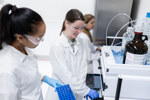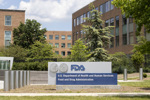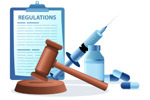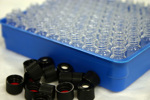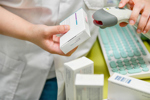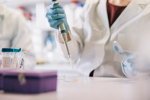-
Doubling Up For Speed In Biomanufacturing
Accelerate drug development and reduce risk with parallel operations. Learn how leveraging CDMO partnerships while building internal capabilities can cut costs and speed your path to market.
-
CDMO Or No CDMO... That Is The Question
Success depends on assessing internal capabilities and knowing when outsourcing can accelerate timelines. Learn how strategic decisions reduce risk, avoid costly delays, and keep your organization competitive.
-
CDMOs - Key Collaborators In Streamlining Drug Development
Accelerating biologics development requires more than speed. Discover how the right CDMO partnership can streamline processes and help you reach the market faster without sacrificing control.
-
Scaling Up Bioprocesses Through A CDMO
Scaling biopharma processes is complex. Learn how flexibility, single-use systems, and strategic partnerships are helping manufacturers overcome these challenges and accelerate time to market.
-
5 Reasons For Outsourcing Chromatography Resin Lifetime Studies
Outsourcing resin lifetime studies accelerates timelines, reduces costs, and minimizes risk. Gain expert support, free up resources, and optimize resin performance without tying up your team or equipment.
-
Is Your Biologics CDMO Transparent?
Transparency and collaboration with a CDMO are vital for reducing risk and protecting IP. Discover four essential practices, from clear communication to IP safeguards, that help build trust.
-
How To Double Up With A CDMO To Reduce Risk
Parallel operations with a CDMO can reduce risk and accelerate timelines by enabling simultaneous process development and manufacturing. Learn how this approach supports facility design.
-
Biologics CDMO: 3 Qualities Often Overlooked
A partnership can deliver more than process support. Transparency, regulatory expertise, and IP protection are critical benefits that safeguard your autonomy and innovation while enabling global success.
-
Product Carbon Footprints: The Next Frontier In Sustainable Innovation
Product Carbon Footprints reveal true lifecycle emissions, enabling collaboration, innovation, and informed decisions. Learn why moving from estimates to evidence is essential for reducing Scope 3 impact.
-
FDA Draft Guidance On CES Signals More Reliance On Toxicity And PK
The technology to measure alternative metrics is vastly improved. Now, FDA joins other regulators in deprioritizing comparative efficacy studies for biosimilars.
-
New Guide Aims To Build Robust Framework For Digital Validation Tools
The ISPE's new guide addresses software for managing digital assets related to qualification, verification, validation, and compliance assurance.
-
Takeda Reimagines Biopharma Quality For The Digital Age
Artificial intelligence, even in its current form, is especially good at synthesizing large data sets. Here's how one company makes the most of it.
-
Collaboration An Untapped Fuel For Driving Biopharma R&D
Biopharma’s future depends on collaboration. Discover how cross-industry partnerships and shared resources can accelerate innovation, overcome talent gaps, and strengthen the global R&D ecosystem.
-
Why Biopharma Breakthroughs Aren't Moving The Market
Biopharma is innovating fast but falling short commercially. Reveal key ecosystem gaps and five strategic actions to help strengthen resilience, accelerate performance, and futureproof organizations.
-
Optimization And Scale-Up Of A Plasmid DNA Production Process
Optimizing pDNA production in E. coli requires strategic media selection and scale-up planning. Explore a study that identifies ideal conditions for high-yield manufacturing.
-
A Risk-Based Approach To Plasmid DNA And mRNA Process Development
Balancing robust analytics and clinical readiness is key for early-phase pDNA and mRNA therapeutics amid structural complexity and regulatory challenges.
-
Take Action On PFAS To Protect Your Critical Processes
PFAS restrictions are tightening, but a full ban could disrupt critical industries lacking alternatives, such as pharmaceutical manufacturing. Learn where PFAS use remains indispensable.
-
Reliably Predicting Biologics Hotspots From Prior Knowledge
Site-specific post translational modifications can seriously affect a molecules stability, function, and structure. These modifications are commonly called "hotspots."
-
Navigating The Regulatory Space To Biosimilar Approval
The biosimilar patent cliff is reshaping pharma, creating unprecedented opportunities for biotech and CDMOs. Explore expert regulatory support that can help you navigate this shift with confidence.
-
Aggregation In Antibody-Drug Conjugates: Causes And Mitigation
Discover how early intervention in ADC development can streamline clinical progress, ensure stability and safety, and accelerate commercialization with expert guidance.
-
The Building Blocks Of A Robust Analytical Assay
Analytical assays aren't just important for quality control. Regulators expect them. These tips will help if you're just starting to build your analytical package.
-
Overcoming Gene Therapy Cost Roadblocks On The Path To Patients
Viral vector-based gene therapies are expanding beyond rare diseases to treat larger populations. Discover how innovations in manufacturing are making these life-changing treatments more accessible.
-
Viral Gene Therapy: Reducing Costs To Improve Patient Access
Gene therapy is revolutionizing medicine with its potential to cure genetic disorders. As approvals rise, so do concerns about accessibility, with million-dollar price tags limiting patient access.
-
3 Key Considerations In Gene Therapy Manufacturing
Viral vector-based gene therapies are redefining medicine. As developers navigate uncharted territory, Sybil Danby of Cytiva highlights three critical areas shaping the journey from discovery to patient access.
-
Ready To Demystify Organoids?
Organoids are transforming biomedical research. Explore their top applications, research workflows, key challenges, and dissociation techniques in this comprehensive guide to personalized medicine.
-
Bio-Based Polymers Towards Net Zero In Single-Use Bioprocessing
Decarbonizing healthcare and pharmaceuticals is vital to meet climate goals and safeguard public health. Learn why these energy-intensive sectors must act swiftly to reduce emissions and navigate complex global supply chains.
-
Scope 3 Emissions: A Shared Challenge, A Collective Responsibility
Despite growing sustainability efforts, our industry lags in climate goals, especially Scope 3 emissions. Discover why bold action and deep collaboration across the value chain are essential for real progress.
-
Don't Miss These 2025–2026 EMA IDMP Compliance Deadlines For Product Management Services
The EMA's Product Management Services will serve as a comprehensive database for consistent identification of medicines internationally. One deadline is quickly approaching on May 31. Are you ready?
-
First AMT Program OK'd Under New FDA Designation — Here's What To Know
The FDA's new Advanced Manufacturing Technology program has its first recipient, a development expected to reveal the specific ways the program benefits drug innovators.
-
Formulation Is Key For Y-mAbs' Self-Assembling Antibody
The radiotherapy company's novel SADA construct uses self-assembling tetramers to deliver isotopes directly to cancer cells for a highly targeted, less toxic treatment.
BIOSIMILAR DEVELOPMENT NEWS
- Zydus And Formycon Enter Into An Exclusive Partnership For The Licensing And Supply Of Biosimilar To Keytruda® (Pembrolizumab), In US And Canada
- Golimumab Biosimilar Gotenfia From STADA And Bio-Thera Receives Positive CHMP Opinion
- Chime Biologics Announces Strategic Collaboration With Beijing Libang Pharmaceutical On Global Blinatumomab Biosimilar Program
- Biosimilars Forum Calls For Congress To Pass The Skinny Labels, Big Savings Act To Support Safe, Effective And Lower-Cost Biosimilars
- Zydus Launches Biosimilar Denosumab 120 mg SC – Protecting Bone Health In Cancer Patients
- Polpharma Biologics And Libbs Farmacêutica Sign Licensing Agreement For A Biosimilar For Autoimmune Diseases
- Sandoz Completes Strategic Acquisition Of Just-Evotec Biologics EU SAS, Asserting Biosimilars Leadership
- Professor Sarfaraz K. Niazi Files Landmark Citizen Petition Urging The FDA To Modernize Biosimilar Approval Pathways And Transform Global Access To Biological Medicines





